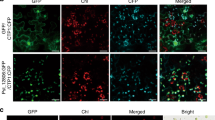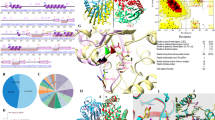Abstract
We generated transgenic sugarcane plants that express an albicidin detoxifying gene (albD), which was cloned from a bacterium that provides biocontrol against leaf scald disease. Plants with albicidin detoxification capacity equivalent to 1–10 ng of AlbD enzyme per mg of leaf protein did not develop chlorotic disease symptoms in inoculated leaves, whereas all untransformed control plants developed severe symptoms. Transgenic lines with high AlbD activity in young stems were also protected against systemic multiplication of the pathogen, which is the precursor to economic disease. We have shown that genetic modification to express a toxin-resistance gene can confer resistance to both disease symptoms and multiplication of a toxigenic pathogen in its host.
This is a preview of subscription content, access via your institution
Access options
Subscribe to this journal
Receive 12 print issues and online access
$209.00 per year
only $17.42 per issue
Buy this article
- Purchase on Springer Link
- Instant access to full article PDF
Prices may be subject to local taxes which are calculated during checkout




Similar content being viewed by others
References
Finlay, B.B. & Cossart, P. Exploitation of mammalian host cell functions by bacterial pathogens. Science 276, 718–725 (1997).
Rudolph, K. in Physiological plant pathology (eds Heitefuss, R. & Williams, P.H.) 207–315 (Springer-Verlag, Berlin, Germany; 1976).
Walton, J.D. & Panaccione, D.G. Host-selective toxins and disease specificity: perspectives and progress. Annu. Rev. Phytopathol. 31, 275–303 ( 1993).
Patil, S.S. & Gnanamanickam, S.S. Suppression of bacterially induced hypersensitive reaction and phytoalexin accumulation in bean by phaseotoxin. Nature 259, 486–487 (1976).
Patil, S.S., Hayward, A.C. & Emmons, R. An ultraviolet-induced nontoxigenic mutant of Pseudomonas phaseolicola of altered pathogenicity. Phytopathology 64, 590–595 (1974).
Anzai, H., Yoneyama, K. & Yamaguchi, I. Transgenic tobacco resistant to a bacterial disease by the detoxification of a pathogenic toxin. Mol. Gen. Genet. 219, 492–494 (1989).
De la Fuente-Martínez, J.M., Mosqueda-Cano, G., Alvarez-Morales, A. & Herrera-Estrella, L. Expression of a bacterial phytotoxin-resistant ornithyl transcarbamylase in transgenic tobacco confers resistance to Pseudomonas syringae pv. phaseolicola. Bio/Technology 10, 905–909 ( 1992).
Johal, G.S. & Briggs, S.P. Reductase activity encoded by the HM1 disease resistance gene in maize. Science 258, 985–987 (1992).
Ricaud, C. & Ryan, C.C. in Diseases of sugarcane: major diseases (eds Ricaud, C., Egan, B.T., Gillaspie Jr, A.G. & Hughes, C.G.) 39–53 (Elsevier, Amsterdam, The Netherlands; 1989).
Birch, R.G. & Patil, S.S. Preliminary characterization of an antibiotic produced by Xanthomonas albilineans which inhibits DNA synthesis in Escherichia coli. J. Gen. Microbiol. 131, 1069–1075 (1985).
Birch, R.G. & Patil, S.S. Evidence that an albicidin-like phytotoxin induces chlorosis in sugarcane leaf scald disease by blocking plastid DNA replication. Physiol. Mol. Plant Pathol. 30, 207–214 (1987).
Birch, R.G. & Patil, S.S. The relation of blocked chloroplast differentiation to sugarcane leaf scald disease. Phytopathology 73, 1368–1374 ( 1983).
Birch, R.G. & Patil, S.S. Correlation between albicidin production and chlorosis induction by Xanthomonas albilineans, the sugarcane leaf scald pathogen. Physiol. Mol. Plant Pathol. 30, 199–206 (1987).
Zhang, L. & Birch, R.G. Biocontrol of sugarcane leaf scald disease by an isolate of Pantoea dispersa which detoxifies albicidin phytotoxins. Lett. Appl. Microbiol. 22, 132–136 (1996).
Zhang, L. & Birch, R.G. The gene for albicidin detoxification from Pantoea dispersa encodes an esterase and attenuates pathogenicity of Xanthomonas albilineans to sugarcane. Proc. Natl Acad. Sci. USA 94, 9984–9989 ( 1997).
Bower, R., Elliott, A.R., Potier, B.A.M. & Birch, R.G. High-efficiency, microprojectile-mediated cotransformation of sugarcane, using visible or selectable markers. Molecular Breeding 2 , 239–249 (1996).
Christensen, A.H. & Quail, P.H. Ubiquitin promoter-based vectors for high-level expression of selectable and/or screenable marker genes in monocotyledonous plants. Transgenic Res. 5, 213–218 (1996).
Hansom, S. et al. Regulation of transgene expression in sugarcane, in Proc. Int. Soc. Sugarcane Technol. XXIII Congress, New Delhi, February 1999 (ed. Singh, V.) In press. (STAI, New Dehli, 1999 ).
Millar, A.J., Short, S.R., Chua, N.-H. & Kay, S.A. A novel circadian phenotype based on firefly luciferase expression in transgenic plants. Plant Cell 4, 1075–1087 (1992).
Lea, P. J. & Leegood, R.C. (eds) Plant biochemistry and molecular biology (John Wiley & Sons, Chichester, UK; 1993 ).
Rott, P., Ael, M., Soupa, D., Feldmann, P. & Letourmy, P. Population dynamics of Xanthomonas albilineans in sugarcane plants as determined with an antibiotic-resistant mutant. Plant Dis. 78, 241–247 ( 1994).
Bevan, M.W., Flavell, R.B. & Chilton, M.-D. A chimaeric antibiotic resistance gene as a selectable marker for plant cell transformation. Nature 304, 184–187 (1983).
Chirgwin, J.M., Pryzbyla, A.E., MacDonald, R.J. & Rutter, W.J. Isolation of biologically active ribonucleic acid from sources enriched in ribonuclease. Biochemistry 18, 5294– 5299 (1979).
Sambrook, J., Fritsch, E.F. & Maniatis, T. in Molecular cloning: A laboratory manual, 2nd ed. (Cold Spring Harbor Laboratory Press, New York; 1979).
Acknowledgements
We thank the Queensland Bureau of Sugar Experiment Stations for assistance with sugarcane. This work was supported by the Australian Research Council and the Sugar Research and Development Corporation.
Author information
Authors and Affiliations
Corresponding author
Rights and permissions
About this article
Cite this article
Zhang, L., Xu, J. & Birch, R. Engineered detoxification confers resistance against a pathogenic bacterium . Nat Biotechnol 17, 1021–1024 (1999). https://doi.org/10.1038/13721
Received:
Accepted:
Issue Date:
DOI: https://doi.org/10.1038/13721
This article is cited by
-
Genetic Engineering Approaches for Enhanced Insect Pest Resistance in Sugarcane
Molecular Biotechnology (2021)
-
Albicidin, a potent DNA gyrase inhibitor with clinical potential
The Journal of Antibiotics (2019)
-
High-efficient Agrobacterium-mediated in planta transformation in black gram (Vigna mungo (L.) Hepper)
Acta Physiologiae Plantarum (2016)



